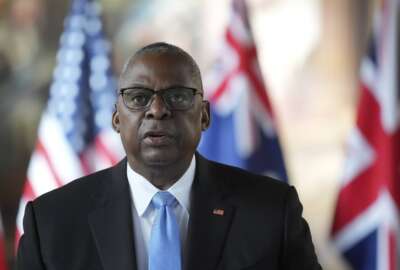Air Force to reshape ‘cost curve’ via targeted acquisition reforms
A new series of acquisition changes called "Bending the Cost Curve" aims to make the overall Air Force acquisition process more responsive to technological adva...
The Air Force is kicking off a series of targeted acquisition initiatives that its leaders hope will bring in more competition, cut out internal bureaucracy and ultimately lead to faster, cheaper procurements.
Deborah Lee James, the secretary of the Air Force, announced the plans under an overall banner she dubbed “Bending the Cost Curve.” She described the initiative as a series of actions that are complementary to DoD’s Better Buying Power initiative — but more specific and tailored than the DoD-wide project.
James said the changes, which the service developed after a months-long series of roundtables with industry groups, will help the Air Force do a better job of communicating with its existing vendor base, welcoming new firms into the fold and removing bureaucratic processes that seem to serve little purpose other than to slow things down.
“We are simply too slow in all that we do,” she told the Atlantic Council Wednesday evening. “Here’s one horrifying factoid: We currently average 17 months to award a contract in situations where we already know there’s only one supplier who can do the work.”
To tackle costs on its major systems, the Air Force will institutionalize a new program that will attempt to make price more of an independent variable in the service’s decisions about precisely what it wants its weapons systems to do.
The cost-capability analysis program (CCA), she said, would incorporate industry’s knowledge about what’s technically possible and affordable much earlier in the acquisition lifecycle, so that the service settles on reasonable requirements before the bigger wheels of the acquisition system start spinning. The hope is those early discussions will let Air Force leaders enter into informed deliberations about whether to trade off extra bells and whistles in favor of lower prices.
“Careful observers may be thinking, ‘Hasn’t this approach been tried before?’ And the answer is ‘Yes, but,'” James said. “The Air Force tried some pilots two years ago, but there was no formalized process for industry to get on board and have that cross-talk with us on a regular basis. So what Bending the Cost Curve will do is reform the way we talk to industry, and when we talk to industry about our requirements.”
Plugfest plus coming soon
James said the Air Force will test the new CCA process on four upcoming programs that are at various stages of the acquisition process: Its new jet trainer, a new long-range standoff weapon, the Multi-Adaptive Podded system, and the forthcoming replacement for the Space-Based Infrared System (SBIRS).
As one way to expand its vendor base and increase competition, the Air Force plans to build on DoD’s existing Plugfest program, an annual series of live demonstrations the DoD intelligence community organizes so that developers and vendors can show off how their products could integrate into DoD’s existing technology architectures.
“These are very well-regarded events, but they don’t have any contracting capability connected to them,” James said. “So here’s how it goes: The government customers might be wowed by what industry demonstrates, but then everybody goes home. There’s no easy way for anybody to follow up, and so nobody does. Industry gets a pat on the back and a gold star, but there’s no mechanism to get that technology on board quickly.”
The Air Force’s spin on Plugfest — “Plugfest Plus” — will host its first event at George Mason University on Jan. 20. James said there will indeed be a way for the Air Force to buy vendors’ wares if it’s “wowed” by what it sees.
If the service finds technologies at GMU that meet capability gaps it wants to fill, it will be able to put money on the line to do so within a few weeks, James said. To do so, the Air Force will make use of other transaction authority, a special legal route that largely sidesteps the Federal Acquisition Regulation and that agencies are allowed to use under special permission from the Office of Management and Budget, usually for rapidly-emerging technologies.
For its first Plugfest, the Air Force will focus on commercial innovations that might help it improve its version of the Distributed Common Ground System (DCGS), a series of military systems for intelligence gathering and analysis.
“We picked DCGS for this first event because it seemed like a good fit, largely because it’s based on open architecture, and open architecture is also key to the whole Plugfest concept,” James said. “If it proves successful, we intend to take steps to evolve the process to other Air Force applications.”
Additionally, the Air Force is launching a new technology challenge program led by the Air Force Research Laboratory. A top prize of $2 million — the largest challenge prize offered by any military service — will go to a project the Air Force deems the most promising solution for a mid-sized jet turbine engine that might be able to help propel future drone aircraft.
Memo outlines 24 best practices
And to begin to tackle some of the Air Force’s internal processes which boost acquisition program costs and delay schedules, the service is making its business information technology portfolio its first target. James said the Air Force will stand up a new business analytics cell within its headquarters. Its objective will be to turn a history of disaggregated series of decisions on new business system spending into an enterprisewide view that invests only in the ones that live up to their promises of increased efficiency.
“The data we’re interested in should help us answer questions such as, ‘Will this new database system really make us 30 percent more efficient? If I spend $5 million on this system today, how long will it take it to pay back that investment?’ That’s what we’re interested in,” she said. “We need a solid enterprise view of our technology spend, and unfortunately, we do not have that at the moment. In the future, if we want to do a database that would accomplish X, we’re going to first have to know that there are metrics that we can measure and that it can deliver.”
Beyond business systems, the Air Force wants to reduce the cycle times of all of its acquisition projects. As part of the “Bending the Cost Curve” project, Bill LaPlante, the service’s acquisition chief, issued a memo to the acquisition workforce outlining 24 best practices his office developed after the industry roundtables.
“We can’t have those ridiculously high 17-month award times when there’s only one vendor,” James said. “We’re enacting those best practices in ways so that we can measure the results, but ultimately, we’re driving to get that down to single digits. We also want to reduce the overall number of contracts where there is only one known supplier, because competition is always better than sole-source.”
RELATED STORIES:
Air Force launches crowdsourcing-like approach to acquisition
On DoD: William LaPlante, Assistant Secretary of the Air Force for Acquisition
Pentagon’s new version of Better Buying Power focuses on technical excellence
Copyright © 2024 Federal News Network. All rights reserved. This website is not intended for users located within the European Economic Area.
Jared Serbu is deputy editor of Federal News Network and reports on the Defense Department’s contracting, legislative, workforce and IT issues.
Follow @jserbuWFED






